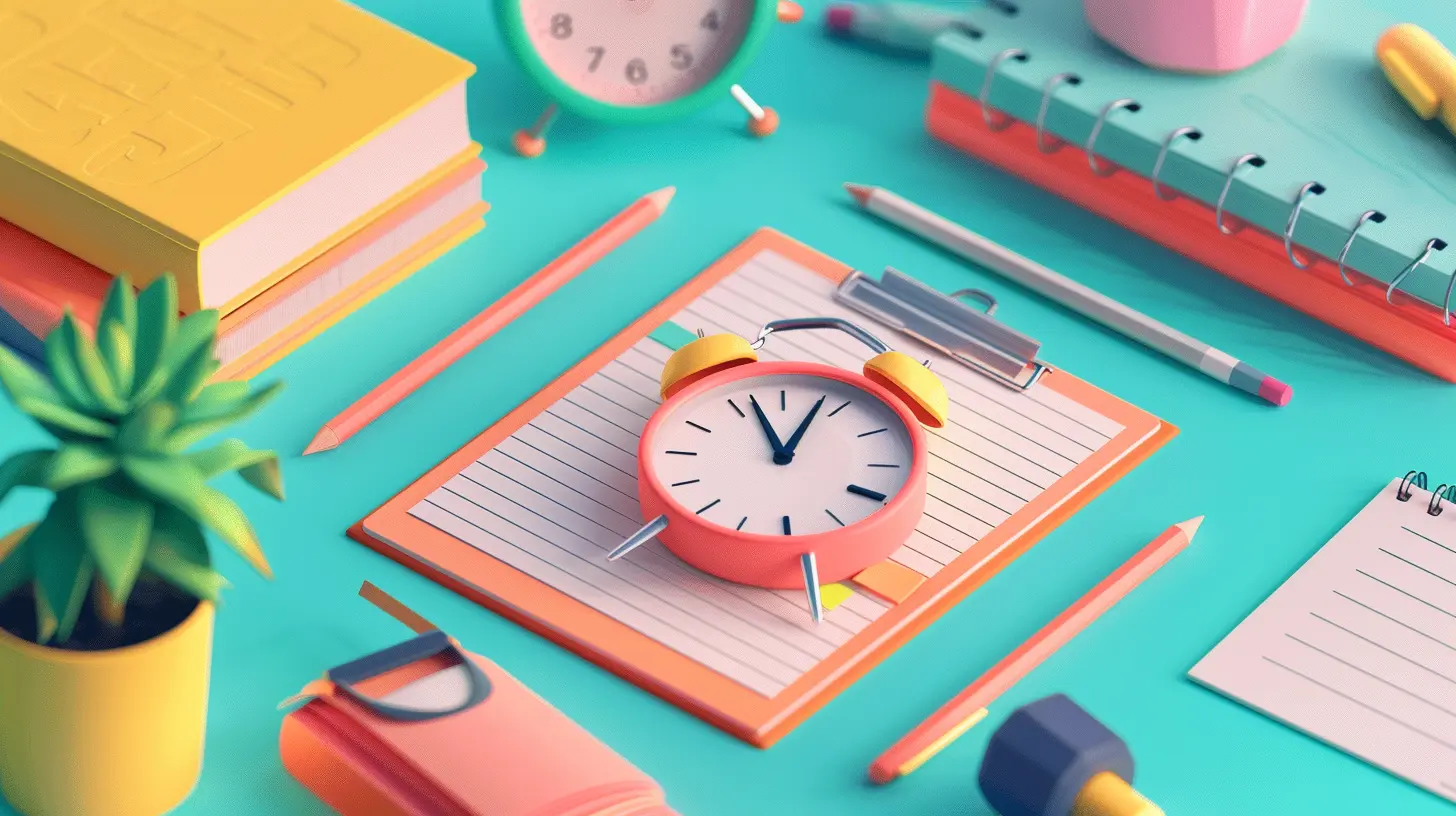How to Create a Study Routine That Maximizes Retention
3 January 2025
We’ve all been there—sitting at your desk with a mountain of notes, textbooks, and a fast-approaching exam date. You study for hours, but somehow, the next day, your brain feels like a sieve, and all the information just slips away. Sound familiar? The good news is, it doesn’t have to be this way. The secret isn't about how long you study but how effectively you study. In this article, we’re going to talk about how to create a study routine that maximizes retention, helping you not just learn but actually remember what you've learned.
Ready? Let’s dive in.
Why You Need a Study Routine
Before we get into the nuts and bolts of creating a study routine, let’s address the "why". Why do you need a study routine in the first place? Well, here’s the thing: our brains thrive on consistency. Just like working out at the gym, you can't expect to build muscle from one intense workout session. Similarly, cramming for an exam won’t do much if you're looking to retain information over the long term. A structured routine helps you:- Build consistency: You’re training your brain to expect study time.
- Reduce stress: Knowing what to study and when eliminates the panic of "where do I start?"
- Improve retention: Repeated exposure to material over time helps solidify the information in your brain.
Step 1: Understand Your Learning Style
Before you can create a study routine that maximizes retention, it’s crucial to identify how you learn best. We all process information differently, so figure out whether you're a:- Visual Learner: Do diagrams, charts, and videos help you retain information better?
- Auditory Learner: Do podcasts, lectures, or discussions work best for you?
- Kinesthetic Learner: Do you need hands-on learning, like writing things down or using flashcards?
- Reading/Writing Learner: Do you prefer to absorb information through textbooks, articles, or notes?
Once you know your learning style, you can tailor your study routine to suit your strengths. For example, if you're a visual learner, you might want to incorporate more mind maps or infographics into your study sessions. If you're an auditory learner, listening to recorded lectures or explaining concepts to a friend might be more effective for you.
Step 2: Break It Down with the Pomodoro Technique
Now that you know how you learn best, let’s talk about when and how long you should study. Spoiler alert: studying for hours without breaks doesn’t work. According to research, our brains can only focus effectively for about 25-30 minutes at a time.One of the most popular study methods that maximizes retention is the Pomodoro Technique. Here's how it works:
1. Choose a task (like reviewing a chapter or completing a problem set).
2. Set a timer for 25 minutes and focus solely on that task.
3. When the timer goes off, take a 5-minute break.
4. After four "Pomodoros" (study periods), take a longer break (15-30 minutes).
This technique helps break your study session into manageable chunks, giving your brain the time it needs to consolidate the information during those short breaks. Think of it like giving your mind a series of mini "workouts" throughout the day instead of one long exhausting session.
Step 3: Use Active Recall and Spaced Repetition
Okay, so you’ve figured out your learning style and are using the Pomodoro Technique to organize your study time. What now? How do you actually retain the information?Two words: active recall and spaced repetition.
Active Recall
This is the process of actively retrieving information from memory rather than passively reviewing notes or textbooks. Instead of just reading over your notes, quiz yourself on the material. You can use flashcards, practice tests, or even explain concepts out loud to see how much you truly understand. Think of it as giving your brain a "workout"—the more you retrieve information, the stronger that memory becomes.Spaced Repetition
Spaced repetition involves revisiting the material at increasing intervals over time. The idea is to review the material just as you're about to forget it. There are several apps, such as Anki and Quizlet, that are specifically designed for spaced repetition learning.Imagine trying to water a plant. If you dump all the water on it at once, it’ll just overflow and won’t absorb much. But if you water it a little bit each day, it’ll grow strong and healthy. Your brain works in a similar way; consistent, spaced-out review helps root the information deep in your memory.
Step 4: Create a Balanced Schedule
Now that you have the techniques down, it’s time to plan out when you’re going to study. Balance is key here—you don’t want to burn out before exam day. Follow these steps to create a balanced study schedule:Prioritize Your Subjects
Start by identifying which subjects or topics need the most attention. Are there areas you're struggling with, or topics that are particularly dense? Prioritize those subjects, but don’t neglect the easier ones either.Block Time for Each Subject
Once you know what needs the most attention, block out specific time slots for each subject. Use the Pomodoro Technique to break these down into manageable sessions. For example, dedicate two hours on Monday for math, but break that up into four 25-minute sessions with breaks in-between.Include Breaks and Downtime
Studying effectively doesn’t mean you have to be glued to your desk 24/7. Make sure to include breaks (both short and long) in your schedule. You should also include time for relaxation and hobbies. Your brain needs downtime to process the information it’s been absorbing. Remember, all work and no play makes your brain a dull sponge!Step 5: Optimize Your Study Environment
Your environment plays a huge role in how well you retain information. If your study space is cluttered or full of distractions, your brain has to work harder to focus. Here are a few tips to optimize your study environment:- Clear the Clutter: A tidy space helps you stay focused. Keep only the essentials on your desk.
- Minimize Distractions: Turn off notifications on your phone or use apps like "Forest" that encourage you to stay off your devices.
- Comfort is Key: Make sure your chair and desk are comfortable, but not too comfortable that you're tempted to nap.
- Lighting Matters: Natural light is best, but if you’re studying at night, make sure your space is well-lit to avoid eye strain.
Step 6: Stay Consistent and Review Regularly
Consistency is the backbone of any good study routine. It’s not enough to study once in a while; you need to make it a habit. Here’s how:- Set a Routine: Try to study around the same time every day. This helps train your brain to get into “study mode.”
- Review Regularly: Don’t just study once and assume you’re done. Use spaced repetition to review the material periodically.
- Track Your Progress: Keep a study journal or use an app to track what you’ve studied and how well you’re retaining the information.
By staying consistent and regularly reviewing the material, you're cementing the knowledge in your brain, making it less likely to slip away when you need it most.
Step 7: Get Enough Sleep and Stay Healthy
You know that feeling when you pull an all-nighter and the next day your brain feels like mush? That’s because sleep is crucial for memory consolidation. During sleep, your brain processes and stores the information you learned throughout the day.No amount of studying will help if you’re not getting enough rest. Aim for 7-9 hours of sleep per night, especially leading up to an exam. Also, don’t forget to eat nutritious meals and stay hydrated. Your brain is part of your body, so keeping your body healthy will keep your brain sharp.
Step 8: Stay Flexible
Even the best-laid plans can go awry, so it’s important to stay flexible. Life happens—you might get sick, have a family emergency, or simply need a mental health day. Don’t stress if you miss a study session or if your schedule changes. The key is to adapt and get back on track when you can.Final Thoughts
Creating a study routine that maximizes retention isn’t about cramming or spending endless hours at your desk. It’s about studying smart, not hard. By understanding your learning style, using proven techniques like active recall and spaced repetition, and maintaining balance in your schedule, you can dramatically improve your ability to retain information.Remember, it’s a marathon, not a sprint. Be patient with yourself, stay consistent, and watch your retention skyrocket.
all images in this post were generated using AI tools
Category:
Test PreparationAuthor:

Olivia Lewis
Discussion
rate this article
18 comments
Cara McCray
This article offers valuable insights on structuring a study routine. Implementing consistent schedules, breaks, and varied techniques can significantly enhance information retention. Great tips!
April 1, 2025 at 2:48 AM

Olivia Lewis
Thank you for your feedback! I'm glad you found the tips helpful for enhancing study routines and retention.
Adrian Hodge
Creating a study routine is essential for maximizing retention. Incorporate active learning techniques, such as summarizing material and self-quizzing. Break study sessions into manageable chunks, use spaced repetition, and ensure regular review. Prioritize a distraction-free environment and set specific goals to enhance focus and motivation for effective learning.
February 22, 2025 at 1:51 PM

Olivia Lewis
Thank you for sharing these valuable tips! Active learning and a structured approach are key to enhancing retention. I'll definitely incorporate these strategies into the article.
Noora Foster
Routine is the canvas; review is the paint—make your learning masterpiece!
February 15, 2025 at 1:43 PM

Olivia Lewis
Thank you! That's a beautiful analogy—combining routine and review truly enhances our learning experience.
Megan McKellar
Establishing a consistent study routine is vital. Incorporate varied techniques like active recall and spaced repetition to enhance retention. Remember, quality over quantity; even short, focused sessions can yield significant results.
February 3, 2025 at 7:45 PM

Olivia Lewis
Absolutely! A consistent study routine, combined with techniques like active recall and spaced repetition, can greatly improve retention. Focusing on quality, even brief sessions, can lead to effective learning outcomes. Thank you for highlighting these key strategies!
Bianca McCartney
Creating a study routine is like baking a cake: mix the right ingredients, let it rise, and don’t forget to enjoy a slice of knowledge along the way!" 🍰📚
January 28, 2025 at 11:58 AM

Olivia Lewis
Absolutely! Just like baking, a well-structured study routine combines the right elements for optimal learning and enjoyment. 🍰📚
Porter McHugh
Great tips in this article! I love the idea of mixing up study locations to keep things fresh. It’s so true that a little variety can really help with retention. I can’t wait to try out some of these strategies in my own routine. Thanks for sharing!
January 23, 2025 at 9:10 PM

Olivia Lewis
Thank you for your feedback! I'm glad you found the tips helpful—mixing up study locations can really make a difference. Happy studying!
Brigitte McGlynn
Great insights! Consistency truly enhances learning retention.
January 16, 2025 at 1:27 PM

Olivia Lewis
Thank you! I'm glad you found it helpful. Consistency really is key to effective learning!
Josie McCullough
Consistent review and active engagement enhance memory retention effectively.
January 11, 2025 at 1:13 PM

Olivia Lewis
Absolutely! Consistent review and active engagement are key strategies for reinforcing memory and improving retention. Thank you for your insight!
Genevieve Carey
Sure, a study routine is great, but if you're still cramming last minute, honey, it’s time to level up your game. Consistency is key, darling!
January 10, 2025 at 7:52 PM

Olivia Lewis
Absolutely! Consistency truly enhances retention. A solid study routine helps prevent last-minute cramming and boosts overall performance. Thanks for the reminder!
Anastasia McAdoo
Thank you for this insightful article! Your tips on creating a study routine are practical and easy to implement. I particularly appreciate the emphasis on consistency and active recall for better retention.
January 8, 2025 at 9:07 PM

Olivia Lewis
Thank you for your kind words! I'm glad you found the tips helpful and practical. Consistency and active recall truly make a difference in retention!
Pamela Acevedo
Great insights! A structured routine truly enhances retention.
January 8, 2025 at 5:28 AM

Olivia Lewis
Thank you! I'm glad you found it helpful. A structured routine really does make a difference!
Quincy McDonough
Stop making excuses! If you want to retain information, commit to a consistent study routine—no shortcuts, just hard work!
January 7, 2025 at 9:51 PM

Olivia Lewis
Thank you for your comment! Consistency is indeed key, and a solid study routine can make a significant difference in retention.
Ella McGuffin
Creating a study routine takes time and patience; be kind to yourself as you learn.
January 7, 2025 at 5:19 AM

Olivia Lewis
Thank you! Emphasizing self-compassion is key to developing an effective study routine.
Micah Ward
Great tips! A balanced study routine makes all the difference—can't wait to implement these strategies for better retention!
January 5, 2025 at 5:11 AM

Olivia Lewis
Thank you! I'm glad you found the tips helpful. Best of luck with your new study routine!
Eliana McVey
This article piques my curiosity! I’m eager to learn how different study routines can enhance memory retention. What strategies have proven most effective? Are there specific techniques that cater to different learning styles? I can't wait to explore new methods for optimizing my study sessions!
January 4, 2025 at 9:16 PM

Olivia Lewis
Thanks for your enthusiasm! Effective strategies include spaced repetition, active recall, and varied study environments. Tailoring techniques like visual aids for visual learners or discussions for auditory learners can also enhance retention. Happy studying!
Meagan Cannon
Thank you for this insightful article! I appreciate the practical tips on study routines. It’s inspiring to see how small changes can significantly improve retention and learning. Keep up the great work!
January 4, 2025 at 4:45 AM

Olivia Lewis
Thank you so much for your kind words! I'm glad you found the tips helpful. Happy studying!
Heather McCool
Consistency and focus are keys to retention.
January 3, 2025 at 9:58 PM

Olivia Lewis
Absolutely! Consistency and focus are crucial for reinforcing what you learn and ensuring long-term retention.
Honor Moore
This article offers valuable insights on structuring study routines effectively. Balancing study sessions with breaks and active recall can significantly enhance information retention for students.
January 3, 2025 at 1:08 PM

Olivia Lewis
Thank you for your feedback! I'm glad you found the insights on structuring study routines helpful for improving retention.
MORE POSTS

How to Choose the Right College for Your Career Goals

Lifelong Learning in the Digital Age: Staying Relevant in a Fast-Paced World

How to Stay Organized with a Study Binder or Digital Workspace

The Future of Homework in a Digital World

Learning from Anywhere: The Rise of Remote and Hybrid Education

The Benefits of Multi-Sport Participation in Youth Development

Crafting Clear and Effective Learning Objectives for Student Success

How to Study Effectively When You’re Short on Time

The Role of Podcasts and Audiobooks in Lifelong Learning

The Role of PE in Supporting Positive Body Image

Mindful Movement: Incorporating Yoga into PE Classes